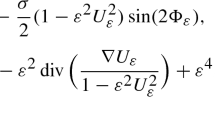Abstract
Fruitful analogies, partially first established by C. M. Newman,(1) between the variables, functions, and equations which describe the equilibrium properties of classical ferro- and antiferromagnets in the Mean Field Approximation (MFA) and those which describe the space-time evolution of compressible Burgers' liquids are developed here for one-dimensional systems. It is shown that the natural analogies are: magnetic field and position coordinate; ferro-/antiferromagnetic coupling constants and negative/positive times; free energy per spin and velocity potential; magnetization and velocity field; magnetic susceptibility and mass density. An unexpected consequence of these analogies is a derivation of the Morette–Van Hove relation. Another novelty is that they necessitate the investigation of weak solutions of Burgers' equation for negative times, corresponding to the Curie–Weiss transition in ferromagnets. This is achieved by solving the “final-value” problem of the homogenous Hamilton–Jacobi equation. Unification of the final- and initial-value problems results in an extended Hopf–Lax variational principle. It is shown that its applicability implies that the velocity potentials at time zero be Lipschitz continuous for the velocity field to be bounded. This is a rather mild condition for the class of physically interesting and functionally compatible velocity potentials, compatible in the sense of satisfying the Morette–Van Hove relation.
Similar content being viewed by others
REFERENCES
C. M. Newman, Percolation theory: A selective survey of rigorous results, in Advances in Multiphase Flow and Related Problems, G. Papanicolaou, ed. (SIAM, 1986), pp. 155–156 and Appendix pp. 163–164.
Ph. Choquard and J. Wagner, The homogeneous Hamilton-Jacobi and Bernoulli equations revisited, II, Found. Phys. 32:1225–1249 (2002).
L. C. Evans, Partial differential equations, in Graduate Studies in Mathematics, Vol. 19, (American Mathematical Society 1998).
Ph. Choquard and F. Steiner, The story of Van Vleck's and Morette-Van Hove's determinants, Helv. Phys. Acta 69:636–654 (1996).
C. Grosche and F. Steiner, Handbook of Feynman path integrals, in Springer Tracts in Modern Physics, Vol. 145 (Springer, 1998).
J. D. Logan, An introduction to nonlinear partial differential equations, Pure and Applied Mathematics(Wiley, 1994).
Author information
Authors and Affiliations
Rights and permissions
About this article
Cite this article
Choquard, P., Wagner, J. On the “Mean Field” Interpretation of Burgers' Equation. Journal of Statistical Physics 116, 843–853 (2004). https://doi.org/10.1023/B:JOSS.0000037211.80229.04
Issue Date:
DOI: https://doi.org/10.1023/B:JOSS.0000037211.80229.04



